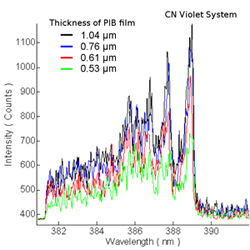Filament-Induced Breakdown Spectroscopy: Fundamentals
Ultrashort laser pulses can easily enter a regime where they no longer propagate as normal beams propagate through the atmosphere. The high irradiance achievable with femtosecond laser pulses leads to the formation of a stable filament that will easily propagate for tens of meters with an intensity of 1014 W.cm-2. We are interested in using these plasma filaments to perform remote spectroscopy by coupling the advantages of Laser induced Breakdown Spectroscopy (LIBS) with the unique characteristics of ultrashort pulse.
Our current research is exploring plasma chemistry resulting from irradiation of organic samples with a self-channeled laser pulses. Using LIBS to determine the atomic composition of a material that contains oxygen and or nitrogen can be troublesome because of the influence of the surrounding atmosphere. We have observed molecular emission indicative of a material that contains both carbon and nitrogen even when the sample does not contain nitrogen. This behavior is likely caused by molecular recombination of atomic carbon with nitrogen from the atmosphere. We are investigating atomic and molecular emission as a function of the surrounding gas composition to better understand this plasma chemistry.
Publications from this project
"Molecular signal as a signature for detection of energetic materials in filament-induced breakdown spectroscopy, " Proceedings of SPIE, volume 7304, pages 73041G-1, 2009.

